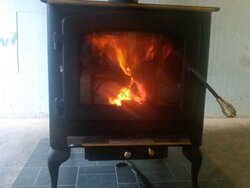Fired off the Englander 30 last night to burn off some paint smell and this morning started a fire from cold to give me a chance to get some learning time on the stove while we got a cooler weekend. For reference, I am also burning my Woodstock Keystone - which is a cat stove vs the Englander secondary burn type.
It took a while to get the firebox up to temperature from a cold start. The goal was to run the stove only hot enough to give me no smoke out the chimney. I'm use to the Keystone's cat lighting off with a 200-250ish stove top temp and the instant I engage the cat - zero smoke. The Englander takes more time. 400 degrees, smoke and really no secondaries. Played with the damper settings knowing that without secondaries of some sort, there would be smoke out the chimney. I opened and closed down the damper in varying stages just to see if I could ignite the secondaries at a lower temperature or get the stove top over 500 degrees and at what damper settings. Even with some secondaries, there was smoke coming out the chimney. Again, the Keystone, once engage the cat - zero smoke - almost like a switch.
I finally got the secondaries to kick-in a bit more intense and walked out and zero smoke coming out the chimney. This was with the spring on the damper control flush with the door ash tray lip. However, with this setting (I am at 500 degrees with a 280 stack temp) I got a goodly amout of flame off the wood. I want to dampen it down some to see what happens. I close the damper all the way, the flames die down, I get some strong secondaries that last for a few minutes then die out and smoke out the chimney returns and my stove top temps fall to about 400 degrees. So back out to flush with the door ash lip and the smoke again dies off as the flames kick in again and the secondaries light off.
What I am trying to do is find the minimum settings vs sending the stove over 700 degrees plus stove top. I know that when I get hotter temps, smoke ain't no problem - I'm just trying to find the lowest set it and forget it temps for when it's time to hit the sack or off to work in the morning for now.
More later!
Oh, all the while I'm tinkering with the Englander, the Keystone is cruzing at 450 degrees with no flames and no smoke out the chimney. This is/has been going on for hours on a bed of coals and two splits!
Bill
It took a while to get the firebox up to temperature from a cold start. The goal was to run the stove only hot enough to give me no smoke out the chimney. I'm use to the Keystone's cat lighting off with a 200-250ish stove top temp and the instant I engage the cat - zero smoke. The Englander takes more time. 400 degrees, smoke and really no secondaries. Played with the damper settings knowing that without secondaries of some sort, there would be smoke out the chimney. I opened and closed down the damper in varying stages just to see if I could ignite the secondaries at a lower temperature or get the stove top over 500 degrees and at what damper settings. Even with some secondaries, there was smoke coming out the chimney. Again, the Keystone, once engage the cat - zero smoke - almost like a switch.
I finally got the secondaries to kick-in a bit more intense and walked out and zero smoke coming out the chimney. This was with the spring on the damper control flush with the door ash tray lip. However, with this setting (I am at 500 degrees with a 280 stack temp) I got a goodly amout of flame off the wood. I want to dampen it down some to see what happens. I close the damper all the way, the flames die down, I get some strong secondaries that last for a few minutes then die out and smoke out the chimney returns and my stove top temps fall to about 400 degrees. So back out to flush with the door ash lip and the smoke again dies off as the flames kick in again and the secondaries light off.
What I am trying to do is find the minimum settings vs sending the stove over 700 degrees plus stove top. I know that when I get hotter temps, smoke ain't no problem - I'm just trying to find the lowest set it and forget it temps for when it's time to hit the sack or off to work in the morning for now.
More later!
Oh, all the while I'm tinkering with the Englander, the Keystone is cruzing at 450 degrees with no flames and no smoke out the chimney. This is/has been going on for hours on a bed of coals and two splits!
Bill



